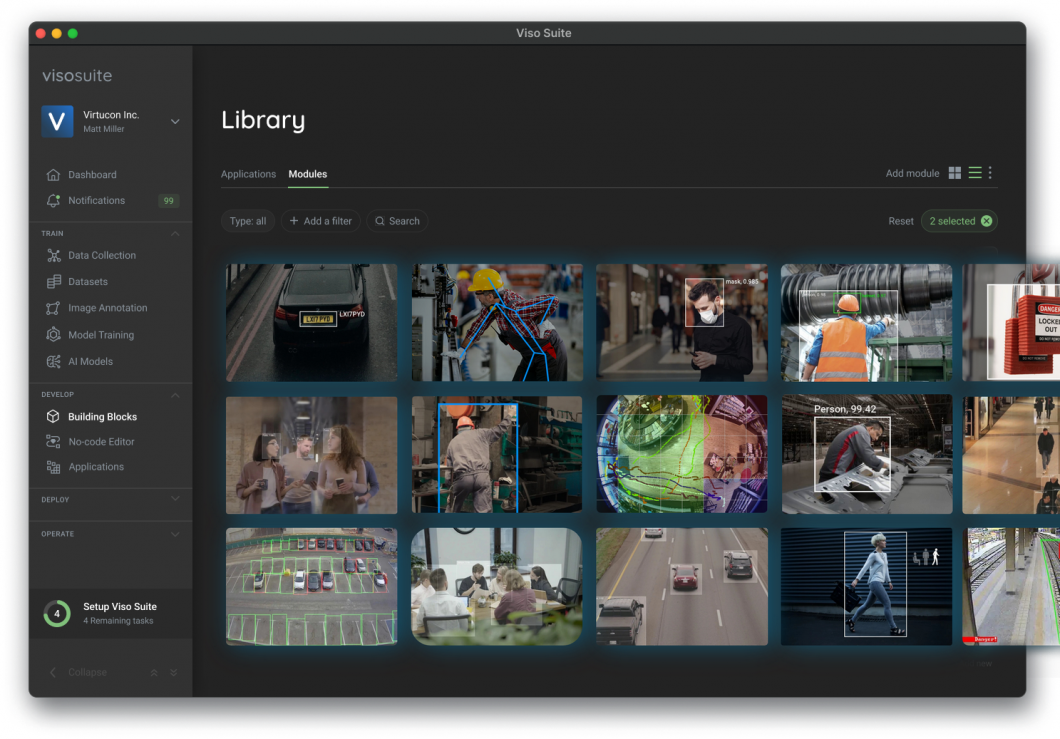As computer vision technology progresses, entities across industry lines are realizing the potential business value held by automating human sight. However, the initial implementation costs and complexity of computer vision and machine learning solutions can often make teams question whether there is a true ROI.
In this article, we will discuss 8 ways to quantify computer vision business value and present the key benefits.
- Operational Efficiency and Cost Reduction
- Revenue Enhancement
- Risk Management and Compliance
- Data-driven Insights
- Competitive Advantage and Heightened Brand Image
- Employee Productivity
- Scalability and Flexibility
- Sustainability and Environmental Impact
About us: Viso Suite is our end-to-end computer vision infrastructure for enterprises. By providing a single location to develop, deploy, manage, and secure the application development process, Viso Suite omits the need for point solutions. Enterprise teams can boost productivity and lower operation costs with full-scale features to accelerate the ML pipeline. Book a demo with our team of experts to learn more.
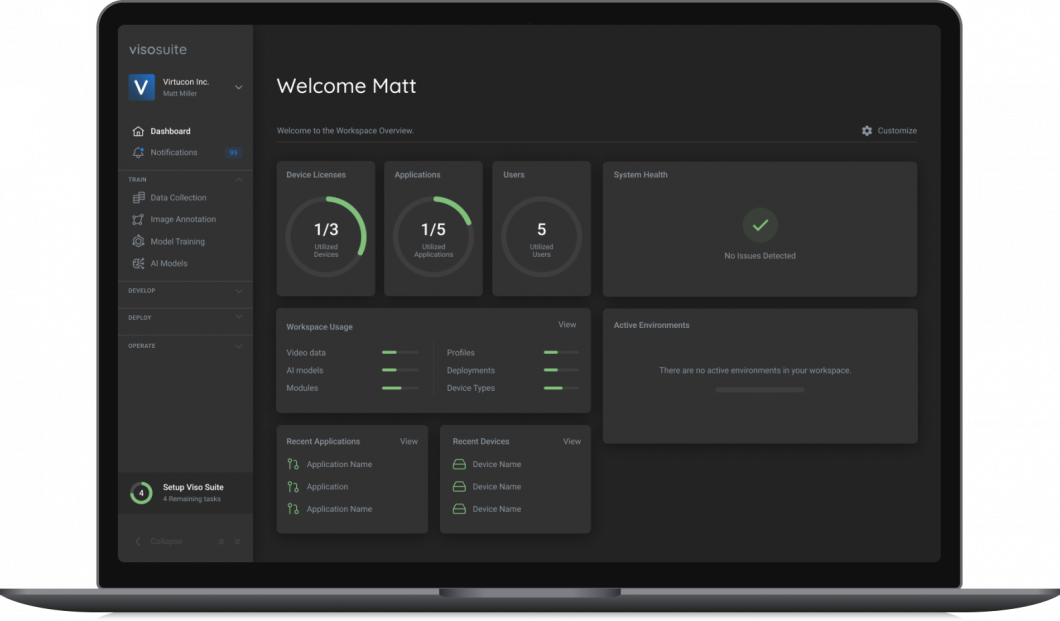
Why Implement Computer Vision?
In many use cases, computer vision is not the only available option for automating business processes. Take attendance tracking in gyms, for example. Gyms have traditionally implemented systems where attendees scan in with an ID card, collecting information on the number of entries and time of day they arrive.
However, information about attendees’ behavioral insights stops there. Once the attendees enter the gym, the key cards don’t provide data on how many machines they visit, how long they spend on each machine, or which machines they use the most frequently.
Additionally, key cards could get lost and the technology becomes obsolete in the medium term, making it necessary to replace the whole system. Point solutions, like that of the key cards, are often hard to scale: for every new client you need a new card. For every new store, you need a new system.
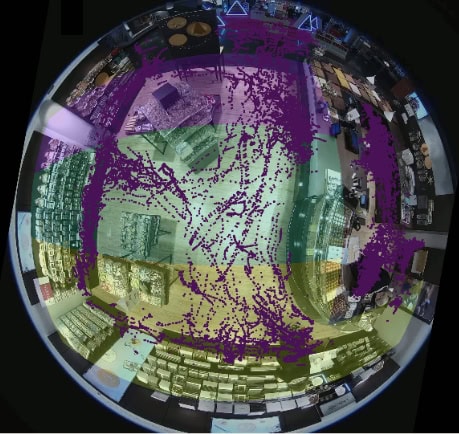
Computer vision technology implemented for such a use case opens a Pandora’s Box of data-driven insights. Through a multi-modal system of cameras and sensors, gyms can understand the flow of foot traffic and behavioral analytics of their attendees, while preserving their privacy and using the most updated technology without upgrading the entire system. This data can then be measured and tracked in real-time. Additionally, enterprise computer vision systems can integrate with existing tech stacks to streamline the implementation process.
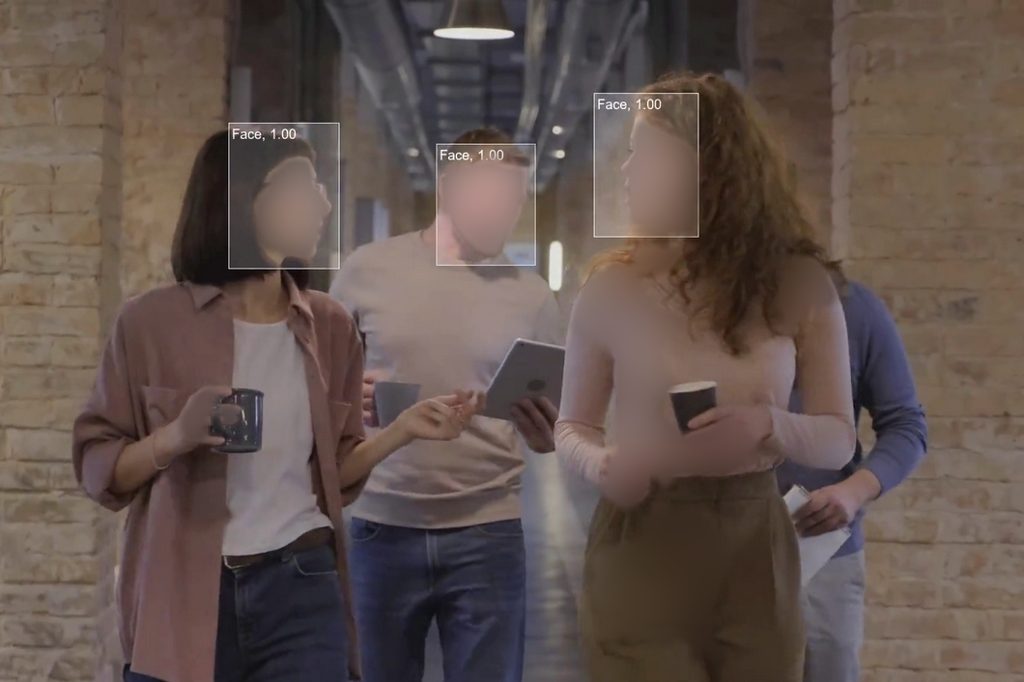
Case Study: Real-world Multi-modal Computer Vision System
Let’s dive into what a full-scale computer vision system would look like in the real world. Here, we’ll take the example of how one of our clients, a large gym chain, used Viso Suite to develop a system to better understand and monitor customer behavior inside each establishment.
- Assign Unique IDs: Each gym attendee is assigned a unique ID, such as a membership card, key fob, or mobile app.
- Scanning into the Gym: Attendees scan into the gym with their unique ID at the entrance via a barcode scanner, RFID reader, or a mobile app check-in system.
- Monitoring with Cameras and Sensors
- Cameras and Sensors Installation: Cameras and various sensors (such as infrared sensors or Wi-Fi/Bluetooth trackers) are strategically installed throughout the gym to monitor crowd density, and footfall traffic, and track attendees.
- Real-Time Tracking: These devices continuously track attendees in different areas of the gym and identify them based on their scanned IDs.
- Data Collection and Integration
- Crowd Density and Traffic Measurement: Sensors and cameras gather data on how many people are in specific areas of the gym, their movement patterns, and overall footfall traffic.
- Attendee Tracking: Unique IDs allow the system to correlate the presence and movement of each attendee with their specific data.
- Real-Time Monitoring and Analysis
- Centralized Dashboard: All collected data is sent to a centralized system for processing and display on a dashboard in real time.
- Data Visualization: The dashboard provides insights into crowd density, peak usage times, and traffic patterns within the gym.
- Benefits and Applications
- Capacity Management: Gym staff monitor real-time occupancy levels to ensure the gym does not become overcrowded, maintaining safety and comfort.
- Resource Allocation: Insights into peak usage times and popular areas help in staff scheduling and equipment maintenance.
- Personalized Services: Based on attendance patterns, gyms offer personalized services, promotions, or recommendations to members.
- Improved Member Experience: Real-time data helps in maintaining an optimal environment, reducing wait times for equipment, and ensuring a better workout experience.
- Historical Data Analysis
- Trend Analysis: Historical data identifies trends and patterns in gym usage over time.
- Operational Improvements: This analysis informs strategic facility decisions, operational hours adjustments, or introductions of new services based on member behavior.
From the real-time information gathered, the gym was able to improve customer experience by optimizing equipment availability, reducing overcrowding, and providing personalized recommendations based on individual workout patterns. With real-time tracking and data integration, gym management could proactively address operational issues, such as adjusting staff allocation during peak hours, maintaining equipment more efficiently, and offering tailored promotions to members. The continuous flow of data also enhanced long-term decision-making, leading to strategic changes that kept the gym competitive and customer-centric.
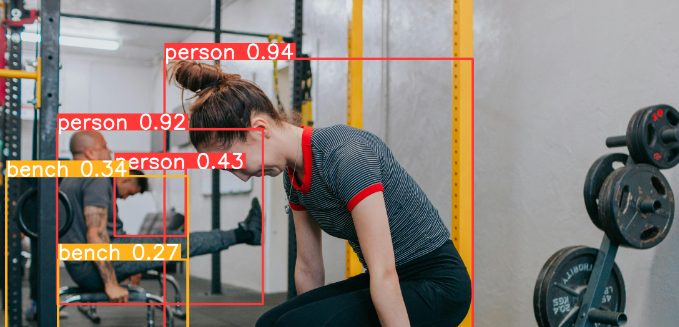
The Computer Vision Market
The rising tide lifts all ships and the increased implementation of AI across domains has sped up computer vision adoption. In a recent study, the global computer vision market was projected to grow by 10.5% CAGR until 2030, when it will top a volume of $47 billion.
This market growth, however, is not just fueled by the adoption of computer vision technology. Both large tech companies and startups alike are jumping into the game to offer innovative solutions. Those looking to develop automated vision solutions can choose from a variety of tools, platforms, and computer vision infrastructures available.
- Open-source Tools: There is a massive variety of open-source tools available, free of cost. Typically, these tools are developed by hobbyists and some companies, looking to give back to the AI community. It is usually necessary to have a background in engineering to get started. Usually, there are limited support options, no enterprise-grade security measures, or end-to-end services available. That being said, open-source tools are great resources for small businesses and hobbyists ready to put in more work developing an application, some examples including YOLOv8, OpenCV, and ONNX.
- Point Platforms: These platforms deliver solutions for specific steps in the machine learning pipeline. This could include image annotation or model training, as examples. As most point platforms offer enterprise options, they are more secure and offer some level of support. However, they do not offer fully end-to-end services.
- Computer Vision Infrastructure: With computer vision infrastructure, users receive support throughout the entire application development pipeline. Additionally, this infrastructure must meet enterprise demands, thus, including military-grade security measures, the ability to scale as the business needs evolve, and full customizability. After trying to use point solutions to complete the entire machine learning pipeline, many businesses turn to infrastructure instead, such as Viso Suite.
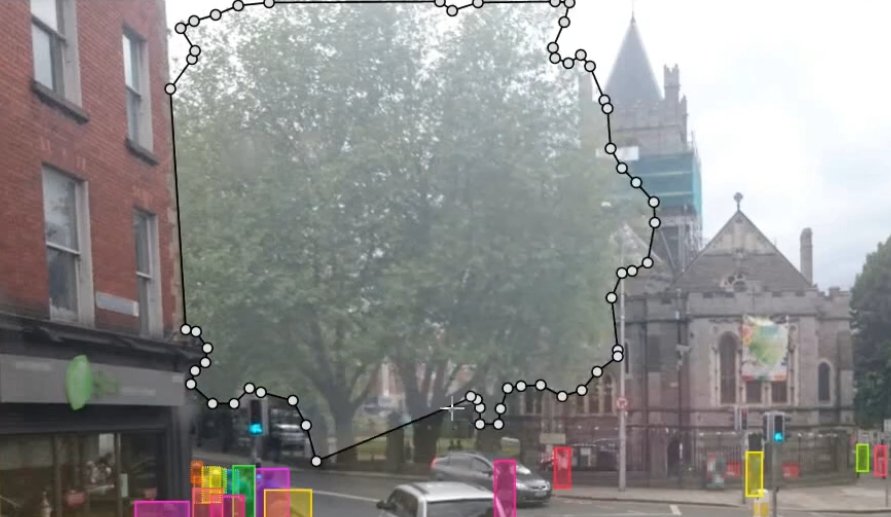
Operational Efficiency and Cost Reduction
Repetitive Task Automation
A well-known advantage of artificial intelligence (AI) technology is the propensity to automate previously menial, time-intensive, and human error-prone tasks. This is particularly evident in data entry, quality control, and inventory management, which are traditionally performed by human intermediaries.
With these labor-intensive tasks now automated, human employees can free up time to focus on more important assignments. This automation ensures that tasks are performed accurately, quickly, and consistently. Thus, leading to faster processing times and increased productivity.
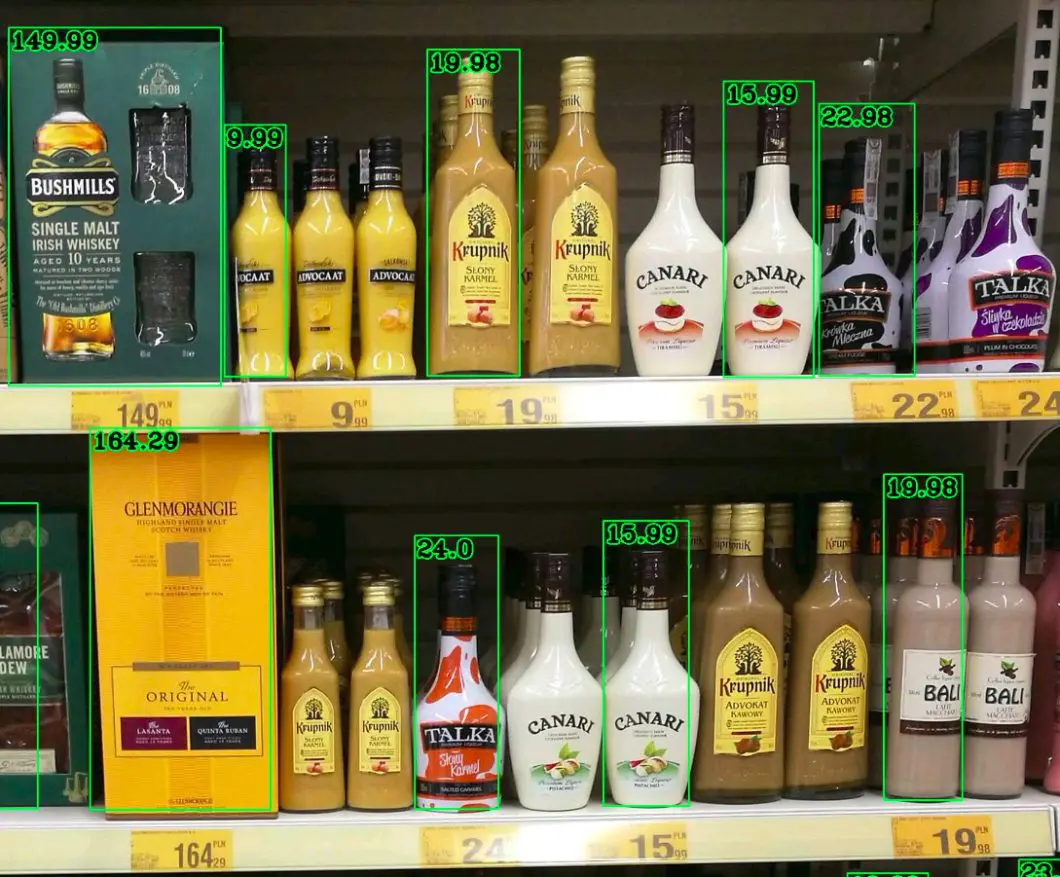
Enhanced Accuracy and Precision
Computer vision systems prioritize high accuracy and precision standards across applications. For example, in quality control on assembly lines, computer vision systems can identify tiny defects difficult to spot with the human eye.
By automating the quality-checking process, enterprises can ensure they only ship the products meeting strict standards. Thus, reducing the likelihood of returns while improving customer satisfaction.
Real-time Monitoring and Data Collection
AI at the edge allows businesses to identify and address problems instantaneously. In retail applications, crowd monitoring can help optimize staff scheduling, which improves customer service during peak times. Retail companies can ensure they are not overscheduling staff while better understanding in-store customer demand.
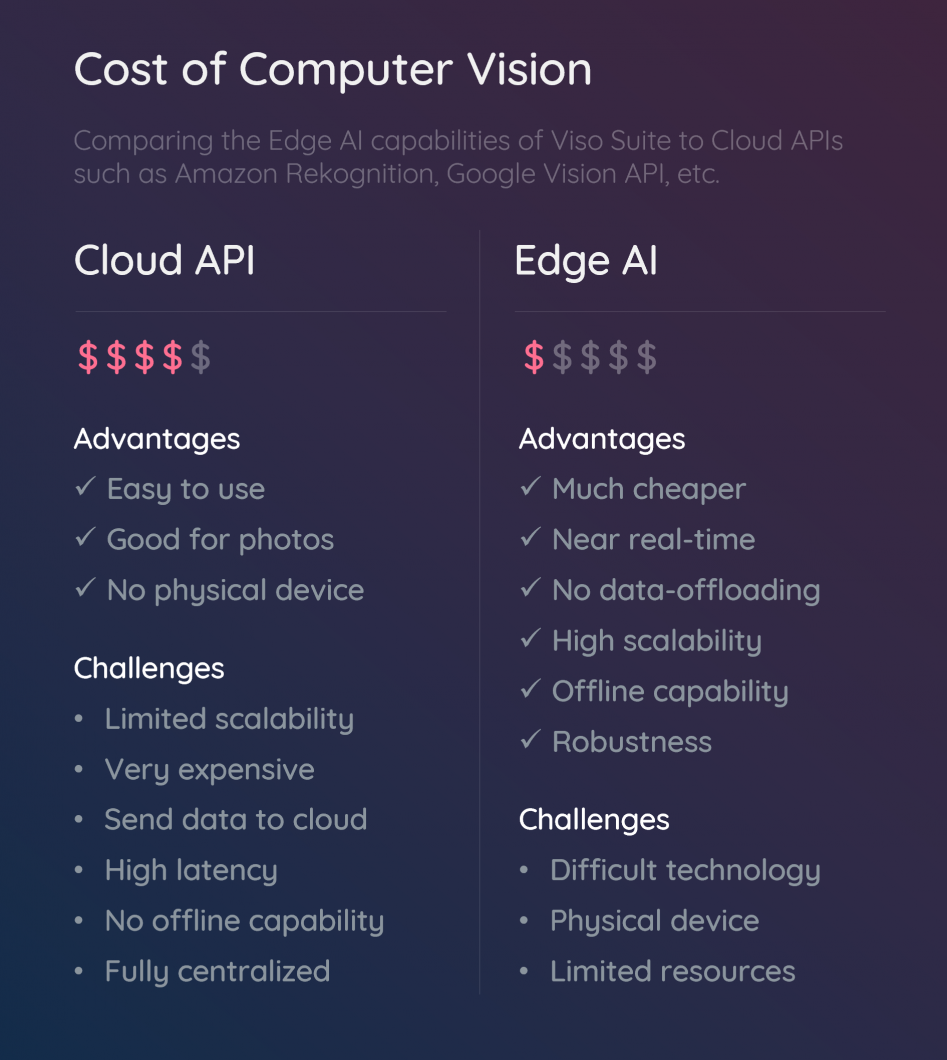
To know how much money you can save by automating repetitive tasks and enhancing accuracy and precision, keep in mind:
Measuring Time Costs
- The number of people who dedicate time to a specific task
- The number of hours each person spends performing the activity
- The hourly rate of your team
Measuring Mistake Costs
- How often a mistake happens
- How much does every mistake cost your business
If your team can use their time more productively, and you can avoid mistakes from happening, most likely an investment in computer vision already pays off.
Teams must also understand the true cost of a mistake. If a computer vision system in an autonomous vehicle makes a mistake, i.e. does not catch a pedestrian crossing in front of a car, the cost could quite literally mean life or death. Some applications require faster, lighter models with lower accuracy, while others must implement larger, heavier models that can produce much higher accuracy. Determining the correct model and system will rely heavily on project requirements.
Resource Optimization
Computer vision insights help businesses optimize resource use such as labor, materials, and storage space. In a warehouse setting, computer vision accurately tracks inventory locations and movements, maximizing space utilization and reducing the need for more storage facilities. All in all, smart resource allocation results in cost savings and improved operational efficiency.
Scalability and Flexibility
Computer vision systems, like Viso Suite, are scalable and easily integrated into existing workflows and tech stacks. As business needs grow, these systems can seamlessly expand to take on increased volumes without a proportional increase in labor costs. Additionally, computer vision technology is adaptable to various industries and applications, offering flexibility to meet specific business needs.
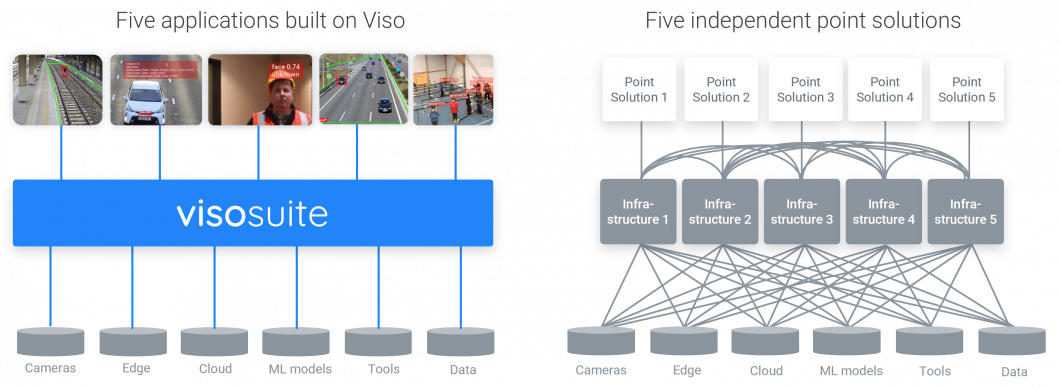
Revenue Enhancement
Businesses experience revenue enhancement opportunities such as improved operational efficiency, heightened innovation, and optimized strategy. As a result, companies deliver superior products and services, capture market opportunities, and drive sustainable revenue growth. We present two common use cases of vision AI.
Use Case 1: Quality Assurance
As mentioned in the above section, computer vision is a vital tool for manufacturers to ensure high production standards by identifying defects. This automation assists in reducing the number of faulty products so that when they go to market, they meet customer expectations. This leads to higher customer satisfaction and brand loyalty, ultimately driving sales revenue.
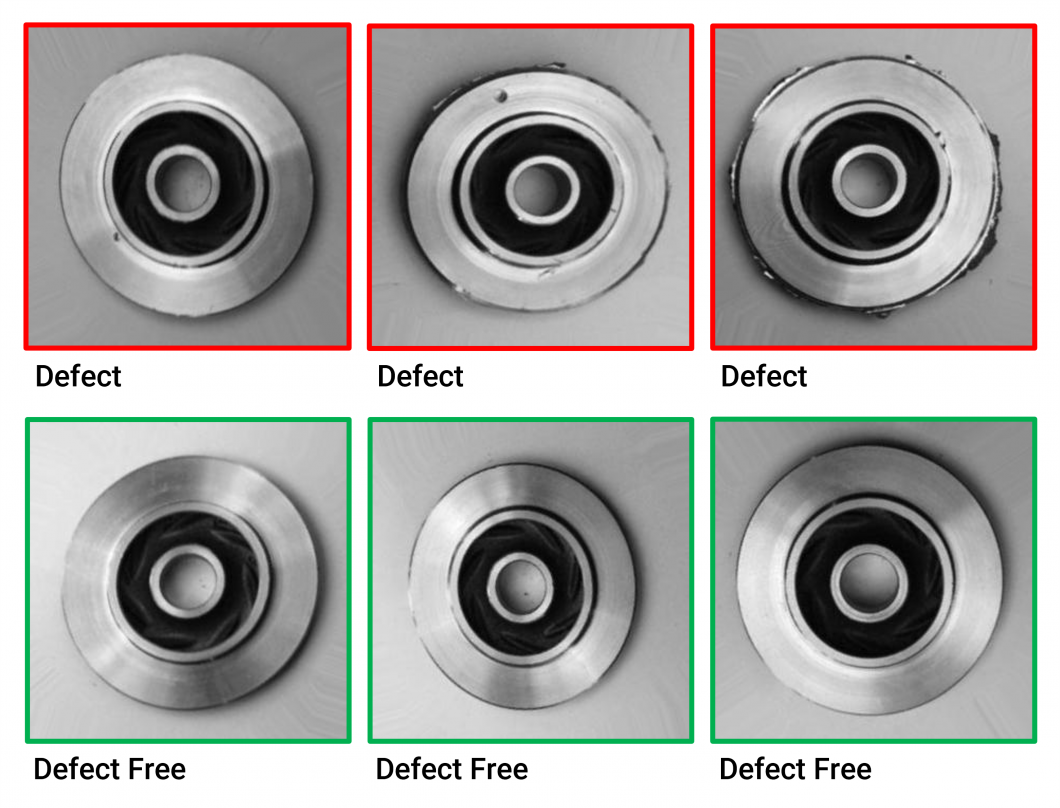
Use Case 2: Predictive Maintenance
Predictive maintenance in the commercial airline industry allows companies to avoid catastrophic problems in dealing with their airplane fleets while maximizing operation efficiency. This proactive approach can quickly identify potential problems, such as metal fatigue and corrosion. These problems can quickly be dealt with to minimize downtime and delays.
Calculating Revenue Enhancements
To know how much you can save by automating quality assurance processes and implementing predictive maintenance practices, you’ll need to consider the following questions:
What are the costs of the teams’ hours?
- The number of people who dedicate time to QA processes
- The number of hours each team member performs QA tasks
- The hourly rate of your team
How much does a mistake cost?
- How often a mistake happens
- How much does every mistake cost your business
- How many hours people need to dedicate to fix the mistake
- How many hours people cannot work because of a mistake
- The hourly rate of your team
- Other liabilities from the observed mistake
How much revenue can you make from a mistake-free process?
- If mistakes are avoided, what is the marginal increase in your production?
- What is the revenue generated by that production?
Risk Management and Compliance
Computer vision provides advanced monitoring and surveillance capabilities. Systems analyze visual data in real time for anomaly detection, risk identification, and alert triggering for immediate intervention. In return, businesses can easily mitigate operational risks while promoting workplace security.
Additionally, automated inspection processes mean that companies can easily adhere to industry standards and regulations. This legal compliance provides companies with the ability to avoid costly fines and penalties.
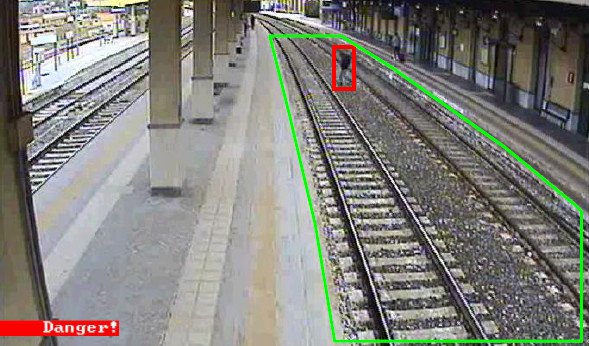
Detect intrusion events in pre-defined areas by identifying the target’s position, date and time.
Data-driven Insights
Computer vision systems extract valuable information from image and video media regarding consumer behavior, product usage, and market trends. By adequately analyzing this data, businesses can better meet customer demand and drive strategic growth initiatives.
Examples of potential insights from this visual data include:
- Patterns
- Anomalies
- Workflow inefficiencies and bottlenecks
- Opportunities for improved resource allocation
A large resort chain used Viso Suite to find out why their customers were not returning to various pools on the property. By analyzing video streams from cameras placed throughout the property, our customer learned that many pool chairs were “pseudo-occupied.” This is because pool patrons would leave their towels on chairs and not return to the pool for the remainder of the day.
To combat this problem, the hotel implemented a computer vision system to monitor how long towels were left on pool chairs. Once a determined time limit was met, the system would send an alert to staff to clear the chair. Thus, freeing up space for more members to visit the pool. This initiative resulted in improved patron satisfaction but also led to cost savings in excess of $1M annually, directly tied to heightened operational efficiency and increased pool-side spending.
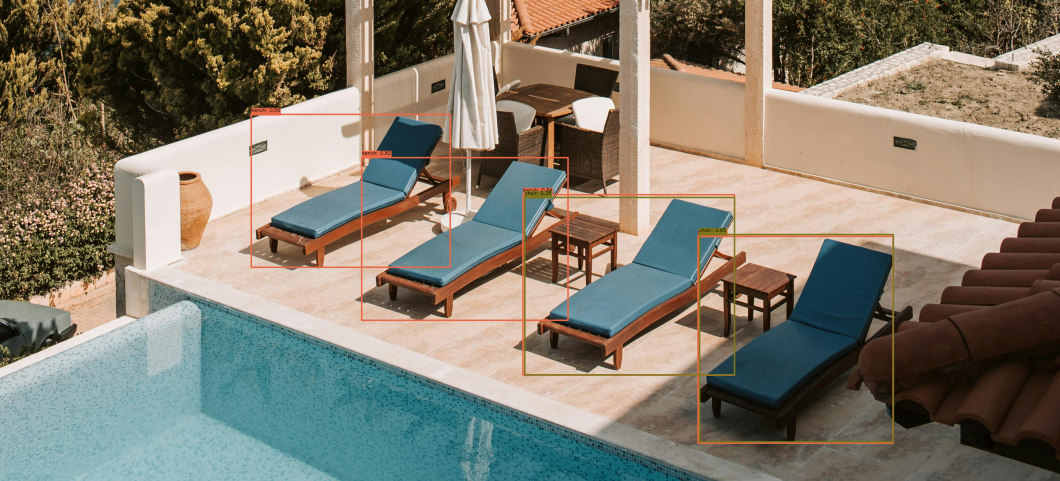
Calculating Revenue from Data-driven Insights
When considering the resort example, to measure the amount of revenue missed from lost opportunities we must consider the following questions:
- When considering the hotels and resort use case, what is the average consumption ticket of a patron in the swimming pool?
- How many guests give up on going to the pool because of the lack of chairs?
- What is the likelihood of a satisfied customer coming back to your hotel?
Competitive Advantage and Heightened Brand Reputation
As computer vision technology is still new, many companies have yet to implement it. However, recent advancements mean that it is not necessary to employ internal specialists to build, deploy, and maintain these automated systems. As a result, companies embracing computer vision early on can gain a first-mover advantage.
Organizations can exploit previously untapped insights to stay ahead of market trends. The potential computer vision applications will continue to expand and offer greater opportunities for businesses to realize the value behind visual data.
Additionally, organizations can position themselves as innovative leaders, willing to adapt to the latest technology. This proactive approach attracts tech-savvy consumers while establishing confidence in stakeholders, who view the company as forward-thinking and industry-leading.
Employee Productivity
There are three main aspects of computer vision promoting employee productivity:
Skill Augmentation
When considering improved time (and resource) allocation, we look back to the automation of labor-intensive tasks. By freeing up employee time to focus on strategic initiatives, problem-solving, and high-return activities, companies get to experience heightened productivity and optimal staff utilization.
Enhanced Decision-making
The insights from computer vision systems allow company decision-makers to ensure they are taking the best course of action. State-of-the-art tools and features mean that companies can rest assured that they have access to high-quality and relevant visual data.
Scalability and Flexibility
End-to-end computer vision systems are developed to be completely scalable and flexible, ultimately evolving with the growth of the business. These full-scale solutions should not result in significant additional costs.
For example, one of our customers is a large international fast-moving consumer goods retailer. In their initial proof-of-concept, they needed to accurately count and track all available pallets within their warehouse using Viso Suite. Upon confirming this possibility, they then aimed to implement this pallet tracking in more than 350 of their warehouses worldwide.
Upon each additional warehouse, the clothing retailer could easily add another video stream to their dashboard for monitoring purposes. The time-to-value of this application was only a matter of weeks.
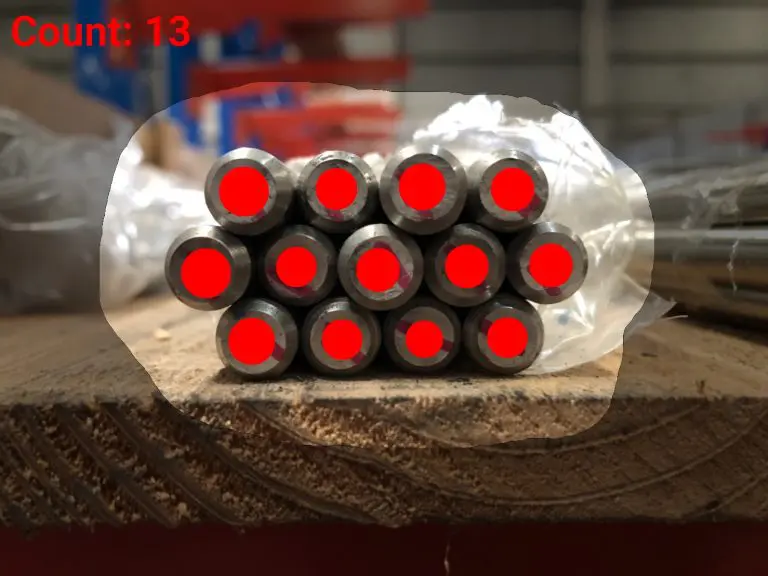
Use cameras for automated object counting with deep learning.
Sustainability and Environmental Impact
A common role that computer vision systems take on is optimizing resource utilization and minimizing waste. Improved quality control processes can produce fewer defective products to reduce the need for rework and material wastage.
Viso Suite has been applied in precision farming techniques by analyzing visual data from drones or satellites to optimize irrigation, fertilization, and crop monitoring. These targeted approaches minimize the use of water and chemicals while maximizing crop yields. In transportation and logistics, Viso Suite optimizes route planning resulting in reduced fuel consumption and greenhouse gas emissions.
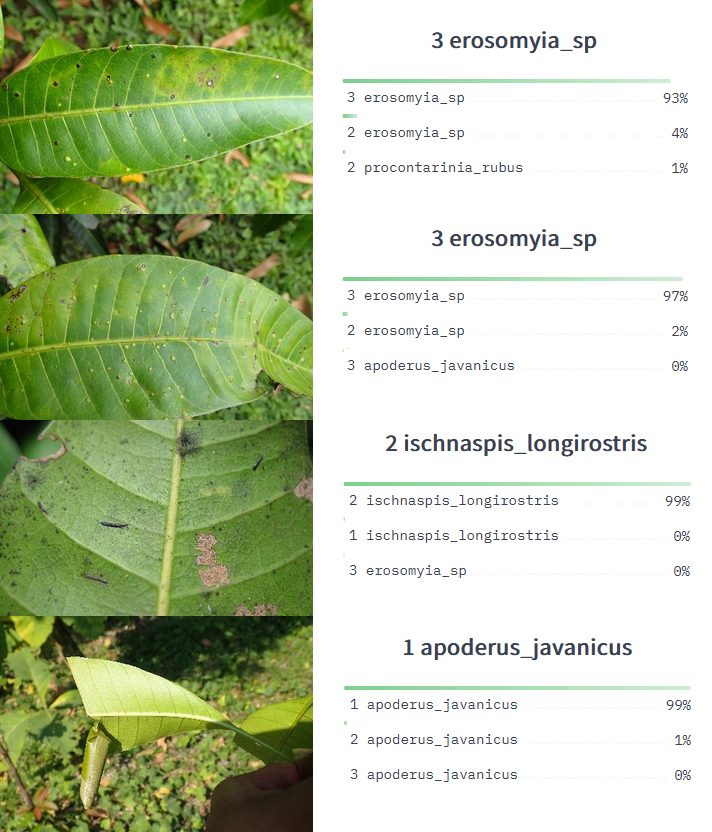
Final Thoughts on the Business Value of Computer Vision
For companies looking to integrate computer vision technology, choosing a solution customized to specific business requirements will be important. Most large companies and enterprises require end-to-end solutions, rather than simple computer vision model training platforms.
We suggest checking out the computer vision platform evaluation guide. Our guide will help you understand the necessary steps to perform during application development, deployment, management, and securing. It will also be worthwhile checking out the true cost of computer vision.
To learn more about the world of AI and computer vision, check out the viso.ai blog:
- Healthcare AI: Improving Patient Health with Computer Vision
- Computer Vision Projects: Inspiration for Implementation
- 100 Popular Use Cases: Computer Vision in the Real World
- Object Tracking: Technical Guide and Use Cases
- Deep Learning vs. Machine Learning: What’s the Difference?
- Facial Recognition: An Easy-to-Understand Overview
Viso Suite Computer Vision Infrastructure
Viso Suite provides enterprise computer vision infrastructure. As the only end-to-end solution, Viso Suite consolidates the entire application pipeline into a robust interface. Learn more about how companies worldwide are using Viso Suite for everyday business solutions.
